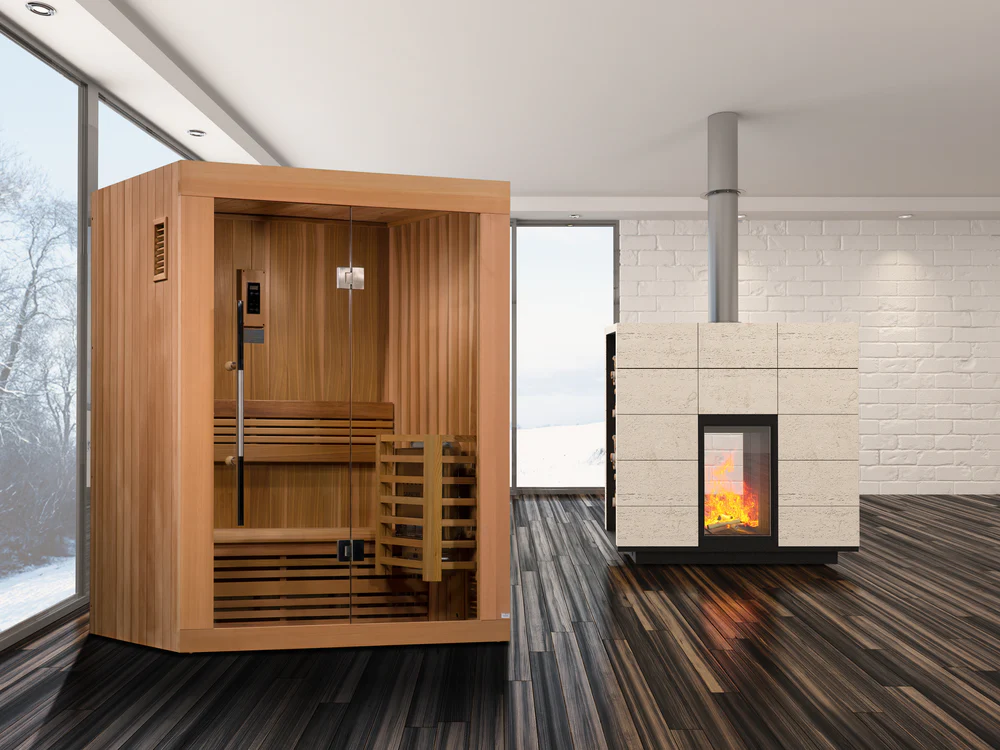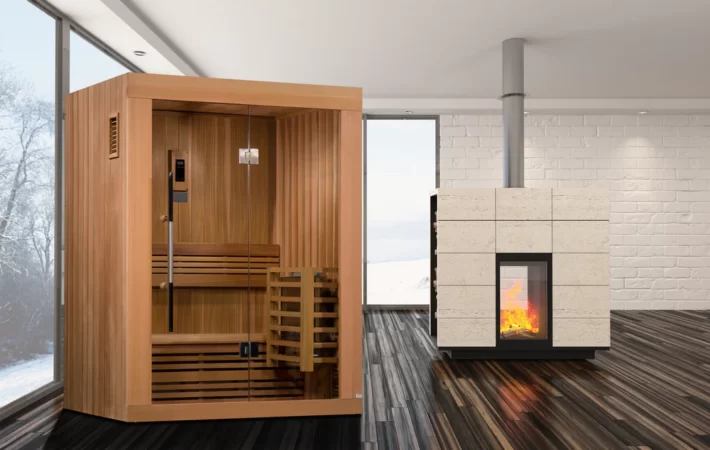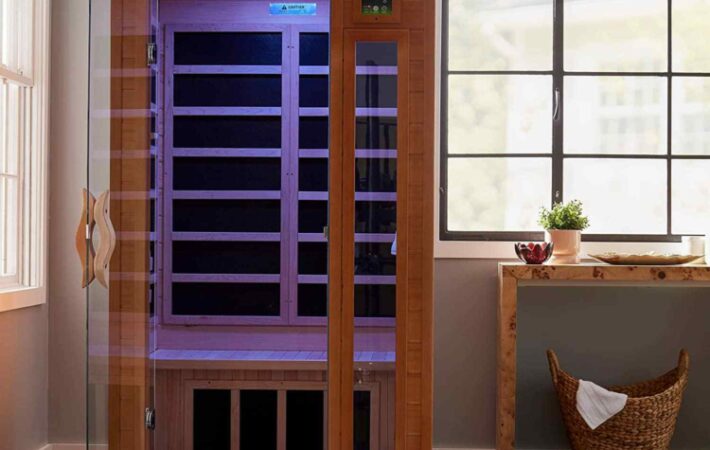In the following post, I’ll look at the benefits of infrared vs. traditional saunas. I’ll also look at various angles, including technology, installation, maintenance, safety, user experience, pricing, and more. By understanding the similarities and differences between these two types of saunas, you can make an informed decision on which sauna option suits your needs, lifestyle, and preferences best.
In short, the traditional sauna experience utilizes high heat and low humidity, whereas infrared uses gentle warmth and deep tissue penetration. Both can provide remarkable benefits for relaxation, detoxification, and overall well-being. The choice ultimately depends on your personal preferences, health goals, space availability, and budget.
Below, I’ll go into more detail and show you the main difference and similarities between infrared and traditional saunas.
A Quick Look
Traditional saunas provide a more intense heat, leading to more sweat, detoxification, improved circulation, and relaxation. On the other hand, infrared saunas provide a more gentle heat that penetrates deeper into the body, aiding in pain relief, muscle recovery, skin health, and enhanced detoxification.
Key Differences
- Infrared saunas uses infrared light to penetrate the skin instead of heating the air like a traditional sauna
- Infrared saunas operate at a much lower temperature of 130 degrees Fahrenheit compared to 180 degrees or more for a traditional sauna
Why Infrared is Better
- Infrared saunas are great for home use because they require less ventilation and maintenance
- They are half the price of traditional saunas and use less energy
- Infrared saunas operate at a lower temperature and are more comfortable
Why Traditional is Better
- There are some unknown risks regarding EMFs in infrared saunas, however, all of our saunas are low EMF and considered safe
- Traditional saunas offer that classic hot sauna feel, whereas infrared might take some getting used to if you are accustomed to the traditional version
Health Benefits
Traditional Saunas
Traditional saunas have been around for thousands of years and typically use hot stones or wood-burning stoves to heat the air inside. These saunas operate at high temperatures, often ranging from 160 to 200 degrees Fahrenheit (70 to 95 degrees Celsius). The heat causes the body to sweat profusely, promoting a variety of benefits.
- Detoxification: Sweating is a natural way for the body to eliminate toxins. In traditional saunas, the high heat causes a deep sweat, which can help cleanse the body of impurities, such as heavy metals and chemicals.
- Improved circulation: The heat from traditional saunas dilates blood vessels, promoting better blood circulation. This increased circulation can help deliver oxygen and nutrients to the body’s tissues, aiding in muscle recovery and overall cardiovascular health.
- Relaxation and stress relief: The intense heat of traditional saunas triggers the release of endorphins, the body’s natural feel-good hormones. This can induce a sense of relaxation, reduce stress levels, and improve mood.
- Respiratory health: Traditional saunas’ hot and dry air can help clear the respiratory system by opening up airways, reducing congestion, and loosening mucus. This can provide relief for individuals with respiratory conditions, such as asthma or bronchitis.
Infrared Saunas
Infrared saunas, a more recent development, use infrared heaters to emit radiant heat directly onto the body, rather than heating the air around. These saunas operate at lower temperatures, typically ranging from 120 to 150 degrees Fahrenheit (49 to 66 degrees Celsius). The infrared heat penetrates the body’s tissues, producing unique benefits.
- Deep tissue penetration: Unlike traditional saunas that primarily heat the surface of the skin, infrared saunas emit radiant heat that can penetrate up to 1.5 inches (3.8 cm) into the body. This deep heat can increase circulation, stimulate metabolism, and promote cellular regeneration.
- Lower heat and more tolerable environment: The lower temperatures of infrared saunas make them more accessible to individuals who may find the intense heat of traditional saunas uncomfortable. The milder temperature allows for longer sessions and extended exposure to the beneficial effects of the sauna.
- Pain relief and muscle recovery: Infrared heat has been shown to have positive effects on pain relief and muscle recovery. It can help alleviate muscle soreness, joint stiffness, and arthritis pain. The deep heat also promotes the production of collagen, aiding in tissue repair.
- Skin health and detoxification: Infrared saunas can have a positive impact on the skin, improving its overall health and appearance. The radiant heat stimulates the production of collagen, reduces signs of aging, and helps clear pores, leading to a more vibrant complexion. Additionally, the deep sweat induced by infrared saunas assists in eliminating toxins and heavy metals from the body.
Infrared vs. Traditional Saunas: An In-Depth Look

The Basics
Traditional saunas have a rich cultural history and are known for their high heat and dry air. They are constructed using materials like wood and feature a traditional heating mechanism that involves heating stones or rocks.
Infrared saunas utilize infrared technology to emit radiant heat, which directly heats the body without warming the surrounding air. They come in various types, including carbon fiber and ceramic heaters. Infrared Saunas are considered to be generally safe, but there are some unknowns about the safety of EMF emitted in infrared saunas.
Temperature and Humidity
Traditional saunas operate at high temperatures, typically between 170°F and 190°F, with low humidity levels of around 10-20%. This creates a dry heat environment that many find invigorating.
Infrared saunas operate at lower temperatures, usually ranging from 110°F to 150°F, with higher humidity levels of around 40-50%. The heat is gentle, allowing for longer sessions without discomfort.
Installation and Space Requirements
Installing a traditional sauna involves construction, proper ventilation, insulation, and electrical setup. Dedicated rooms or outdoor installations are common, requiring adequate space and consideration of building codes, this is an important difference in infrared vs. traditional saunas.
Infrared saunas typically come in pre-built kits and offer easier installation options. Pre-built units and portable models are available, requiring less space and setup. They can be placed in existing rooms without major modifications.
Energy Efficiency
Traditional saunas consume more energy due to their high heat requirements. They take longer to reach optimal temperatures, resulting in higher energy usage. However, energy-efficient models and timers can help manage consumption.
A plus for infrared when comparing infrared vs. traditional saunas, is energy efficiency. They heat up quickly and require less power, resulting in lower energy consumption and costs. They are a popular choice for those mindful of energy usage.
Maintenance and Care
Traditional saunas require regular cleaning and maintenance. This includes cleaning the sauna cabin, maintaining wood surfaces, and ensuring the proper functioning of the heater and ventilation systems.
Infrared saunas are relatively easy to maintain. Regular cleaning of the sauna cabin and infrared heaters is necessary. However, there are no additional requirements for wood maintenance or ventilation systems, making them perfect for a basement.
Safety Considerations
Both traditional and infrared saunas require certain safety precautions. Traditional saunas pose a risk of burns, dehydration, and overheating. It is important to follow guidelines for time limits, hydration, and proper sauna usage.
Infrared saunas have minimal safety concerns. However, some models may emit electromagnetic fields (EMF). Mitigating exposure through low-EMF models or keeping a safe distance from the heaters is recommended.
User Experience and Preferences
Traditional saunas offer the classic sauna experience. The high heat and dry air create a sense of intense warmth, promoting sweating and detoxification. Traditional saunas also provide a social atmosphere, allowing for group sessions and conversations.
Infrared saunas offer a different user experience. The gentle heat directly penetrates the body, providing a soothing and relaxing sensation. Many people appreciate the milder temperature, making longer sessions more comfortable. Infrared saunas also come in various designs, including modern and compact options, catering to individual preferences and space constraints.
Pricing and Cost Factors
When considering the pricing and cost factors, it’s essential to look at both the initial investment and long-term costs associated with each sauna type.
Traditional saunas typically involve higher initial costs due to construction, materials, and ventilation requirements. Maintenance costs, including wood treatment and potential repairs, should also be considered.
Infrared saunas have a wide price range, depending on the size, features, and quality of the unit. While they may have a lower initial investment compared to traditional saunas, it’s important to consider factors such as warranty, durability, and energy efficiency to assess long-term costs.
Conclusion
Both traditional saunas and infrared saunas offer numerous health benefits. Traditional saunas provide intense heat and deep sweating, promoting detoxification, improved circulation, and relaxation. On the other hand, infrared saunas provide a more gentle heat that penetrates deeper into the body, aiding in pain relief, muscle recovery, skin health,
Taking into consideration the facts provide about infrared vs. traditional saunas, we recommend infrared saunas due to their affordability, ease of use, and ability to install anywhere. Even though there are some risks related to EMFs, the research shows infrared saunas emit such a low EMF that there is nothing to worry about. If price and space are not a limiting factor to you, then a traditional sauna would be the way to go.







Leave a comment
Your email address will not be published. Required fields are marked *